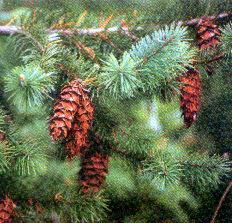 |
|
ECOLOGY Pseudotsuga menziesii is this true pine’s Latin name, and it is classified into a separate genus unto itself. Doug fir became the state tree in 1939 and has continued to thrive in the Northwest as well as south into California and as far east as the Rockies Mountain Range. Its long time claim to fame has been its use as a holiday Christmas tree. It stands anywhere from 40 to 60 feet tall, and is considered the king in Northwest forests. It is identifiable by the spiral pattern in which the needles arrange on the branch. The needles are dark green, about an inch long and when squeezed give off a citrus/lemony smell, and its cone has three distinctive bracts protruding from each scale. The bark starts out smooth and grayish-brown on younger trees, and then becomes rough, thick, and furrowed as the tree grows older. It grows best in well drained soils with ample sunlight and water.
|
|
HISTORY Many Native American tribes have used various parts of the Douglas fir. In northern California, the resin was used to poultice cuts. The Yuki of the California coast used the spring buds to treat venereal diseases, and the Sinkyone also of CA used the bark for tea which eased colds and stomach ailments. Pioneers were known to boil the cones as a coffee substitute! Many animals eat parts of the Doug fir as well, including chickadees, finches, deer, and meadow mice.
|
 |
|
ECONOMICS
|
POLICY AND MANAGEMENT
*Compiled from a paper by Amanda Chidsey |
|